What are spam texts (SMS)?
Spam text messages are any unwanted texts sent to your phone. Spam texts are commonly sent from unknown numbers, often marketing a product or service. But, spam can also be a form of phishing meant to trick victims into giving up sensitive information or clicking malicious links.
Robots can send spam messages automatically through an email or instant messaging service. To block legitimate companies’ marketing ploys, replying “STOP” should stop spam texts. But, replying to an actual scammer won't work — once they know you’re a real person, they’ll likely spam you even more.
Here are some tips to teach you how to stop spam texts:
 Don't
Don't
-
Reply
-
Click any links or buttons
-
Forward messages with links (the link “expands” when forwarded, telling the scammer you're real)
-
Put your phone number into online forms unless required
-
Call 800, 888, or 900 numbers without hiding your number first
 Do
Do
-
Report spam texts (remove any links first)
-
Inform your mobile service provider
-
Use call-blocking or text-blocking apps
-
Filter unknown senders through your phone's settings
-
Block contacts that spam you
-
Download antivirus software as spam insurance
Those are just the basic steps — there's more to learn if you really want to know how to stop spam texts from scammers.
How to stop spam texts
To stop spam texts on Android, open the Phone app and tap Menu (three dots). Tap Settings > Block numbers, then choose from unknown senders, recent calls, or your contact list.
To stop spam texts on iPhone, go to Device settings and tap Messages > Message Filtering. Turn on Filter Unknown Senders.
Filtering unknown senders on an iPhone works like the Junk folder in your email. You won’t receive notifications from these numbers, and their spam texts will be sent to a separate SMS folder. Spam texts can get around blocks by slightly changing their numbers, but some third-party apps know how to stop spam texts by blocking the country code.
 You can block or report spam numbers straight from the spam text you receive, or from your phone’s message settings.
You can block or report spam numbers straight from the spam text you receive, or from your phone’s message settings.
How to report spam texts
A good way to stop spam texts is to report them and cut the spammers off at the source. There are four ways to report spam texts: forward the spam message to 7726, report the spam directly in your messaging app, report it to your wireless provider, or report spam texts to the FTC (in the US).
-
To report spam messages through text, copy the message contents, remove any links, and forward it to 7726 (SPAM). This works in the US, because forwarding spam to 7726 sends it directly to AT&T’s spam defense team.
After you spot a spam text, report it right away. Not only can reporting it stop you from getting spam texts, but it can help others too.
Even though reporting spam is helpful, the scammer is probably using a spoofed phone number, which is a type of attack — called spoofing — that lets scammers hide from cyberpolice.
While you’re learning how to report text spam, protect yourself from fraud by learning what identity theft is and how it works — spam texts and cybercrime are more connected than you might think. And consider what you might be doing that’s causing spam texts and potentially compromising the safety of your identity online.
Why am I getting spam texts?
You could be getting spam texts because someone is trying to access your personal information. Or, the spam might be the result of a data leak or you sharing your number online. Of course, the spam could also be coming from a company you’ve dealt with in the past that still has your number.
Here are some common reasons you’re getting spam texts:
-
Your number was generated randomly by a robot.
-
A social media or other type of company sold your number.
-
Your number was exposed in a data breach.
-
You entered your phone number into a sketchy site.
-
You replied to a spam text, exposing your number to other spammers.
-
You reported a spam text or forwarded it without removing the link first, and accidentally validated your number as active.
-
You called an 800, 888, or 900 number, which allows telecommunications networks to use Automatic Number Identification (ANI) to identify you — and give your info away.
Once one piece of information about you is out there, it's easy for scammers to track you and attack from multiple angles — such as spam texts or emails.
Email phishing scams also try to trick you into divulging your password, credit card number, or other sensitive details. Read up on email security to learn how to block spam email messages.
Text message scams: phishing text messages
When spam texts are sent to tons of people randomly, they're called phishing texts. Phishing texts "phish" for details such as possible passwords or information about your bank account. Phishing texts are often associated with malware that infects your phone as soon as you click a link or reply.
Phishing scams, such as phishing texts, cast wide nets hoping to catch something, while spear phishing targets bigger fish — like a CEO or specific organizations — by using specific info about the victim in order to appear trustworthy.
Along with some tricks to avoid spam, learning the most common scams can help you spot spam texts from a mile away.
Here are some common text message scams:
-
Low-interest credit cards offers
-
Debt or loan relief
-
Offers to clean up your credit report
-
Get rich quick or fast money schemes
-
Congratulatory messages asking you to redeem a prize
-
Government refund claims
-
Alerts of suspicious activity on your account
-
Claims of a payment problem
-
Problems with a delivery or purchase
Don't risk replying to a text if you're suspicious. Confirm the message by visiting the website you think the spam text might be referring to — chances are it's a scam. And for full online threat protection, use antivirus for Android or iOS.

How to block spam texts on iPhone
Even with Apple’s strong security reputation, iPhone spam text messages can still be problematic. Here's how to block text messages on iPhone:
-
Open a text from the spam sender you want to block. Tap the sender’s number and then tap Info.
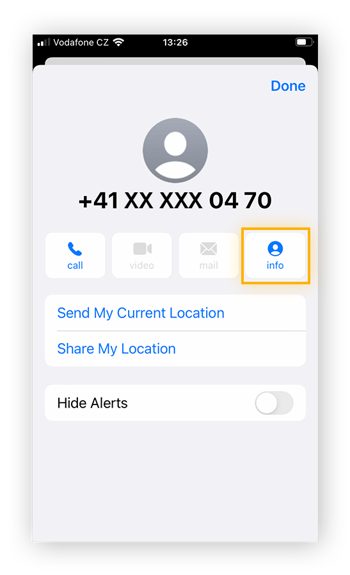
-
Select Block this Caller and confirm by tapping Block Contact.
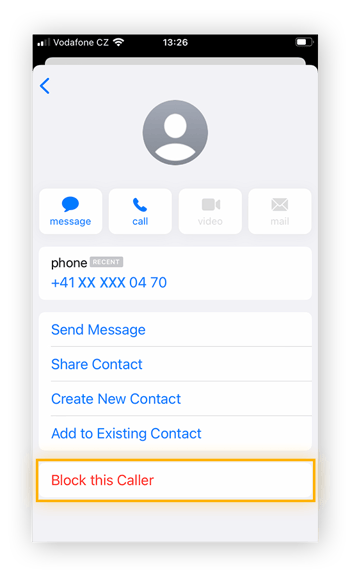
You can also filter iMessage texts from unknown senders. Here’s how:
-
Open iMessage settings and tap Messages.
-
Scroll to Message Filtering and tap Filter Unknown Senders so the toggle turns green. You should now stop getting random text messages from unknown numbers.
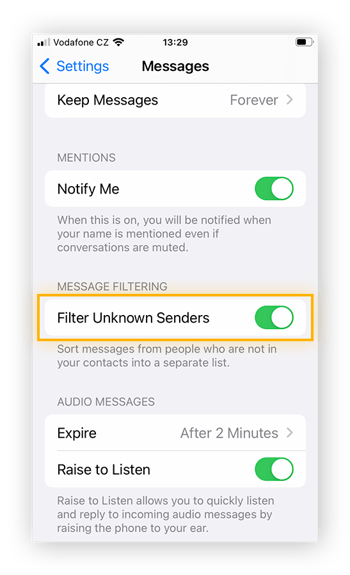
That's how to block texts on iPhone. To help ensure you stop getting spam texts in the future, check out our guide to essential iPhone security tips — and learn how to hide your iPhone apps to increase your digital privacy even more.
If all else fails, spam-response apps for iPhone can help you keep spam at bay.
Best spam response apps for iPhone
Spam texts are such a problem for mobile phone users that an entire industry of spam-blocking apps has emerged. Here are some of the best spam response apps for iPhone:
Bouncer
Bouncer is a free iPhone app that sends (bounces) spam to other folders, like an email spam filter. Bouncer filters bogus texts to junk, promotions, transactions, or any other folder you designate.
 Pros
Pros
 Cons
Cons
-
Doesn't block the number, just hides the spam from it
-
Supported languages are limited to English, Spanish, and Arabic
VeroSMS
VeroSMS is a free app that filters texts through keywords, so you can copy and paste the spam texts you're getting and send them to a junk folder.
 Pros
Pros
-
Free
-
Crowdsources keywords by region to keep up with current spammer trends
-
Auto-blocks texts with links from unknown senders
-
You can add an unlimited number of words to allow or block lists
 Cons
Cons
TextKiller
TextKiller focuses on filtering unwanted texts. It automatically filters legitimate messages from spam. You can also block texts by number, email address, or specific message content.
 Pros
Pros
-
Free, with in-app purchases
-
Blocks texts from emails or random numbers
-
Blocks texts based on keywords you add
-
Strong developer support
 Cons
Cons
Spam texts that include clickable links can also install malware on your phone. If you’re worried you accidentally clicked a link or forwarded a spam text including a link, learn how to remove spyware from an iPhone. Then, read up on the best iPhone security apps and ensure your family’s Apple devices and personal info stay safe.
How to block spam texts on Android
Unsecured messaging apps might be leaking your data — or even selling it outright. Ensure you’re using the best privacy apps for Android, which can help keep your phone number private. But if some spam still gets through, here's how to block spam texts on Android:
-
Open your Phone app, tap Menu (three dots), and select Settings.
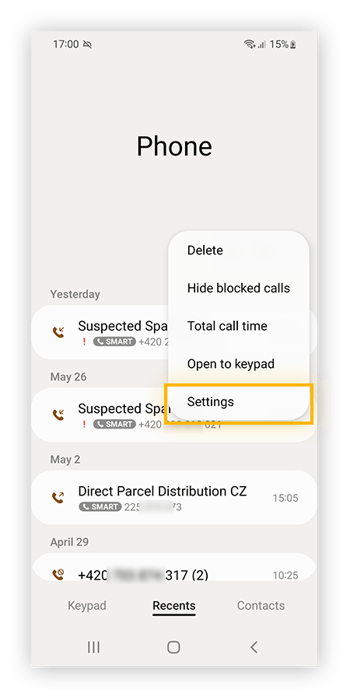
-
Tap Block numbers.
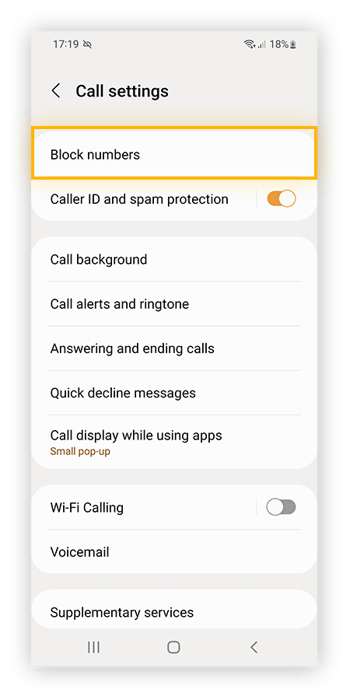
-
Choose the number(s) you want to block. You can block all unknown/private numbers, suspected spam numbers, known contacts, or add a specific phone number you want to block.
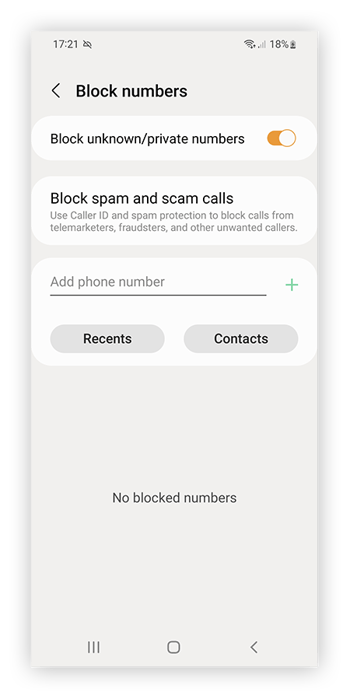
Some apps can also sneakily gain permissions that allow them to collect data, which they sell to advertisers who spam you. Learn how to use Android permissions smartly and restrict background app data on your phone if you suspect one of your apps compromising your privacy.
So much spam can be overwhelming. Thankfully, some Android apps can get rid of spam texts automatically.
Best spam response apps for Android
Responding to texts or letting them open can put ransomware or spyware on your phone. Check out our guide to Android ransomware and keep your phone from getting hijacked. Or, learn how to remove spyware from Android if you think your phone is already infected.
Here are the best spam-response apps for Android to keep your phone free of spam texts.
Textra
Textra is a reliable messaging app that lets you block texts. Many people make Textra their default messaging app after discovering it, because it has some nifty features like the ability to change the look of the app.
 Pros
Pros
-
Custom blocking options
-
Clean, minimal interface — with dark mode
-
Robust feature list, such as time-delayed messaging, quick replies (replying without leaving the app you're in), and group messaging
-
Free tier
 Cons
Cons
Robokiller
Robokiller is designed around scam protection via text and calls. Robokiller wastes the time of scam callers by directing them to bots — letting you get revenge while remaining spam free.
 Pros
Pros
-
Free trial
-
Fun answerbots to play with
-
Predictive blocking technology blocks spam texts automatically
-
Voice print remembers spam caller voices
 Cons
Cons
Hiya Protect
Hiya Protect is a popular spam blocking app. It’s so reliable that even major companies such as Verizon and AT&T use it to report spam texts and block them.
 Pros
Pros
 Cons
Cons
If installing an extra spam-blocking app intimidates you, many of the best secure message apps also have options for blocking spam. Most of them will also encrypt your messages for additional privacy, which helps keep your data private from future spammers.
Block spam with AVG
Spam isn’t just annoying — it can also harm your device. That’s why it’s important to use a cybersecurity app that keeps the malicious software spammers love to use off your phone.
AVG AntiVirus FREE protects you on multiple fronts. Phishing protection blocks unsafe links in text messages, Email shield keeps scam emails at bay, and real-time updates keep you protected against the lastest spamming techniques. Keep your phone safe from the effects of spam messages with AVG.

 You can block or report spam numbers straight from the spam text you receive, or from your phone’s message settings.
You can block or report spam numbers straight from the spam text you receive, or from your phone’s message settings.











